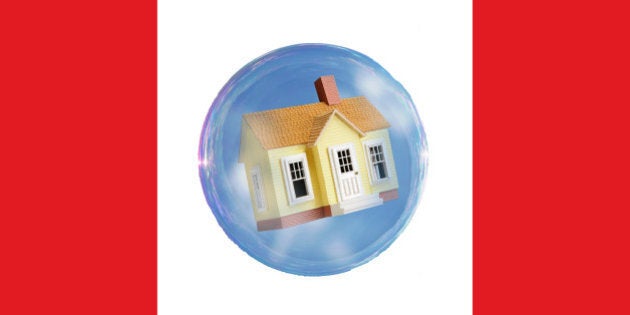
When business professor Ian Lee asked a taxpayer-funded, multibillion-dollar insurance scheme for information about the risks in its portfolio, his request was denied. The information was deemed “commercially sensitive,” he recalls being told.
But it wasn’t, Lee insists. The Canada Mortgage and Housing Corp. is a government-run institution, not a commercial competitor. He was not asking for names or personal information, but for aggregated data about the borrowers most likely to default on their mortgage.
“They used this as an excuse to cloak what they were doing,” he said. But Canadians deserve to know more, Lee believes, because every taxpayer has a stake in the high-risk mortgage game.
The Canada Mortgage and Housing Corporation’s insurance portfolio is currently worth $551 billion — equivalent to 30 per cent of Canada’s gross domestic product — and taxpayers ultimately bear the brunt of responsibility for covering any defaults.
As talk about a potential housing bubble and rising debt loads looms over the Canadian economy, there are growing calls for change at the CMHC — ranging from providing more transparency with its data on the Canadian housing market to reining in its mortgage insurance business, or even getting out of mortgage insurance altogether.
Federal laws require mortgage insurance for anyone who cannot scrape together 20 per cent of a house’s value for a down payment. That tacks another one to three per cent onto the cost of a mortgage. Using August’s national average selling price of $398,618, that amounts to an extra $12,556 for an owner with just five per cent down.
CMHC’s mortgage insurance business was founded in 1954 to provide cover for banks, which were reluctant to lend to riskier borrowers. Its existence means there is zero risk for banks on the insured mortgages they approve. By encouraging banks to lend more, it has helped millions of Canadians gain access to home ownership.
But as a result, CMHC has been accused of fuelling an overheated housing market with taxpayer money.
Some are concerned that the government’s explicit stake in the mortgage game could cause a real estate crash as bad as — or even worse than — the one the United States went through in 2008-2009, because taxpayers would be on the hook to pay for every loan that goes bad. In the U.S., most mortgage insurance is provided by private companies.
It’s not that anyone is accusing the government of wrongdoing – Canada’s safe-lending practices during the recession earned it international praise as a bastion of safety against the worst effects of the U.S. housing crisis.
Even so, the CMHC’s own policies before the crisis were too lax for many industry observers, including then-Bank of Canada governor David Dodge.
In 2006, for instance, CMHC agreed to back mortgages from homeowners with no down payment at all. That level has since been raised to five per cent, and the government has moved four times since the recession to tighten requirements.
The agency’s role has expanded from its initial 1946 mandate — to help foster home ownership during a post-war home shortage. It is now involved in everything from social housing projects to a green homes initiative.
Many feel the scope of the Crown corporation has become too large.
The International Monetary Fund took the unusual step last year to advise Canada to scale back its mortgage insurance business.
In one of his final speeches as finance minister, Jim Flaherty said “regrettably, CMHC became something rather more grand, I think, than it was intended to be.”
As of the end of June, about 45 per cent of all Canadian residential mortgages were covered by CMHC insurance. About one-third of all residential mortgages are now securitized (packaged and resold by banks to investors as bonds), up from 10 per cent in the early 2000s.
The government provides guarantees of principal and interest payments to investors in mortgage-backed securities, making them a safe and attractive investment, but also exposing the government to the very products behind the U.S. housing crash.
Ottawa also backs 90 per cent of another nearly $200 billion covered by two private insurers, Genworth Canada and Canada Guaranty. That means taxpayers are ultimately on the hook for more than half of the $1.1 trillion in outstanding mortgages.
There isn’t too much competition among the insurers. CMHC insures about 70 per cent of the market. All three raised their premiums at the same time. Canadians with less than five per cent equity in their home now pay 3.15 per cent of the value of their mortgage in insurance premiums.
Some vocal industry watchers, such as Carleton University professor Lee and the C.D. Howe Institute’s Finn Poschmann, want the CMHC’s insurance business to be privatized to protect taxpayers and foster more competitive pricing and products.
The business has been profitable so far and delinquency rates are very low, less than 0.5 per cent. That’s not the issue. The question is why the government is in the mortgage insurance business in the first place, when it doesn’t own life or auto insurance companies, Lee said.
“The government of Canada shouldn’t own the hockey teams that it’s refereeing,” he said.
Rob McLister, editor of CanadianMortgageTrends.com, points out that privatization would also mean more people would be rejected for mortgages. The CMHC was founded to help people who would normally be rejected, such as those who live in rural and smaller markets that may not be served by private insurers.
If the CMHC isn’t there to help those people, the private sector certainly isn’t going to, he said, since it has less incentive to help risky low-income borrowers buy a home. In addition, investors in securitized mortgages feel safer having the government than a private company as a partner in case of default.
Even the CMHC’s critics see privatization as an extreme scenario that would require years of deliberation.
But if privatization isn’t going to happen any time soon, should the corporation make reforms to protect taxpayers in the event of a crash? And should taxpayers have access to information about what it is they’re funding?
The CMHC’s new president and CEO, Evan Siddall, seems to think so. In the 10 months since he was appointed, the former Bank of Montreal and Goldman Sachs banker has worked toward changes.
Under his direction, CMHC has raised insurance premiums, stopped insuring second houses, undertaken a study of how many condos are investor-owned and stopped insuring new condo construction.
It may not sound revolutionary to the average Canadian, but Siddall said in a recent speech that the institution is “looking into risk-sharing with lenders to further confront moral hazard.”
The CMHC declined a request for an interview with Siddall but a spokesperson confirmed in an email that it is “re-examining our role in the Canadian housing and financial markets” and exploring ways to “further strengthen Canada's housing finance framework.”
Risk-sharing with the banks would mean lenders would pay a certain amount out of pocket before the insurer pays out the balance when a homeowner defaults. It’s a solution that’s being floated by top economists.
Some believe part of the Canadian market’s heat comes from lenient lending processes that might be a little more stringent if lenders had “skin in the game,” Ian Lee said.
“We know that people’s behaviour — both individuals and corporations — changes ... when they have some of their own skin or money or resources at risk.”
Although the CMHC says it is open to considering a new way to do business, it also cautions there are no immediate plans for an overhaul. Finance Minister Joe Oliver has said the government’s decision to study changes such as passing on more risk to lenders is more of a long-term issue that does not require immediate movement.
“Any changes being considered would require consultation with the industry and careful consideration by CMHC, the Department of Finance and other federal agencies,” the agency said in a statement to HuffPost.
But the agency is moving towards transparency. Just a few months ago, it started releasing a “supplement” along with its quarterly financial statements that includes more information about its insurance portfolio, including breakdowns of the type of insured borrowers by province, credit score and loan amount. That will help Lee and others conduct the sort of trend analysis he feels is needed to help shed light on the potential risks to taxpayers in the event of a crash.
“I think we are slowly, slowly going in the right direction,” Lee said.
“Good public policy needs good information. And when you’re talking about something as technical as mortgages and real estate values, you can’t work in a vacuum, just flying around without data. You need hard data to see the trends.”
Also on HuffPost:
